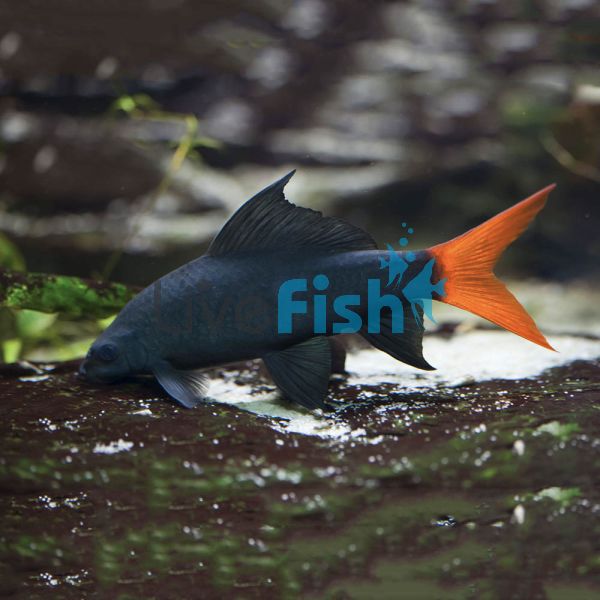Red Tail Shark 4cm
The Red Tail Shark is one of the most contrasting freshwater fish in the aquarium hobby, known for its bold coloration and sleek, torpedo-shaped body. Originating from the freshwater rivers and streams of Thailand, this species is quite popular aquarists with its contrasting jet-black body and bright red tail. Their vibrant appearance and utilitarian purposes make them a popular choice for a variety of aquarium setups, from community tanks to larger fish displays.
Red Tail Shark
The Red Tail Shark is one of the most contrasting freshwater fish in the aquarium hobby, known for its bold coloration and sleek, torpedo-shaped body. Originating from the freshwater rivers and streams of Thailand, this species is quite popular aquarists with its contrasting jet-black body and bright red tail. Their vibrant appearance and utilitarian purposes make them a popular choice for a variety of aquarium setups, from community tanks to larger fish displays.
As their name suggests the red tail shark is known for its bold blood red tail, this is contrasted by the rest of the body which is a straight jet black. Whilst these fish are not true sharks and are more closely related to goldfish, their body shape, large dorsal and pectoral fins along with the pointed face give them a shark like appearance. Red tail sharks get sizeable at around 15 cm which makes them a great addition to cichlid aquariums as well since these fish often go over surfaces like the hardscape in the aquarium rasping for food. This behaviour is quite like what plecos, or sucking loaches do and whilst these aren't a big algae eater they do help in cleaning the aqua scape by keeping detritus moved and by eating uneaten food.
Breeding Red Tail Sharks in captivity is quite rare and challenging. They are egg layers, and in the wild, they spawn in specific environmental conditions that are hard to replicate in a home aquarium. Sexing these fish is also quite hard as males and females look the same, more times than not these fish are wild caught or bred in large outdoor ponds overseas.
Tank Recommendations for your Red Tail Shark
The red tail shark is a territorial fish with other tank mates, but they can be kept in a community setting. The only requirement is that they need adequate space to ensure their territory is not often encroached on by other fish. For this reason a minimum of 200 litres is required for this fish which offers ample space for it and a range of other tank mates.
A tank with plenty of hiding spots, such as caves, driftwood, and dense vegetation, is ideal to mimic their natural habitat and provide territories. These fish appreciate a fine gravel or sandy substrate and benefit from a well-oxygenated environment with moderate water flow. Maintaining water conditions with a pH of 6.5-7.5 and a temperature range of 22-26°C will ensure they thrive.
Suitable Tank Buddies
Red Tail Sharks can be territorial and aggressive, especially towards similar-looking species. however with adequate space they are fine with a wide range of other aquarium species.
Usually Compatible
Top and Mid dwelling fish such as black widow tetras, giant danios, angelfish, Congo tetras and similar species.
Sometime Compatible
Yoyo loaches and dwarf cichlids which may occupy the same water column as the red tail shark along with small fast-moving tetras.
Rarely Compatible
Other red tails sharks and larger highly aggressive species such as jaguar cichlids.
Feeding your Red Tail Shark
The red tail shark is a very easy fish to feed. It is an opportunistic feeder and will readily eat a wide range of foods being both dry, fresh and frozen. Their diet should contain good quality sinking pellets with frozen food that have high protein such as bloodworm, brine shrimp and daphnia.
| Scientific Name | Epalzeorhynchos bicolor |
|---|---|
| Care Level | Easy |
| Common Names | Red Tail Shark |
| Diet | Omnivore |
| Fish Family | Cyprinidae |
| Lifespan (years) | 8 |
| Max. Length (cm) | 15 |
| Min. Tank Volume (l) | 200 |
| Origin | Thailand |
| Reef Safe | Yes |
| Sociability | Semi-aggressive |
| Venomous | No |
| Water Conditions | 22-26° C, pH 6.0-7.5 |




